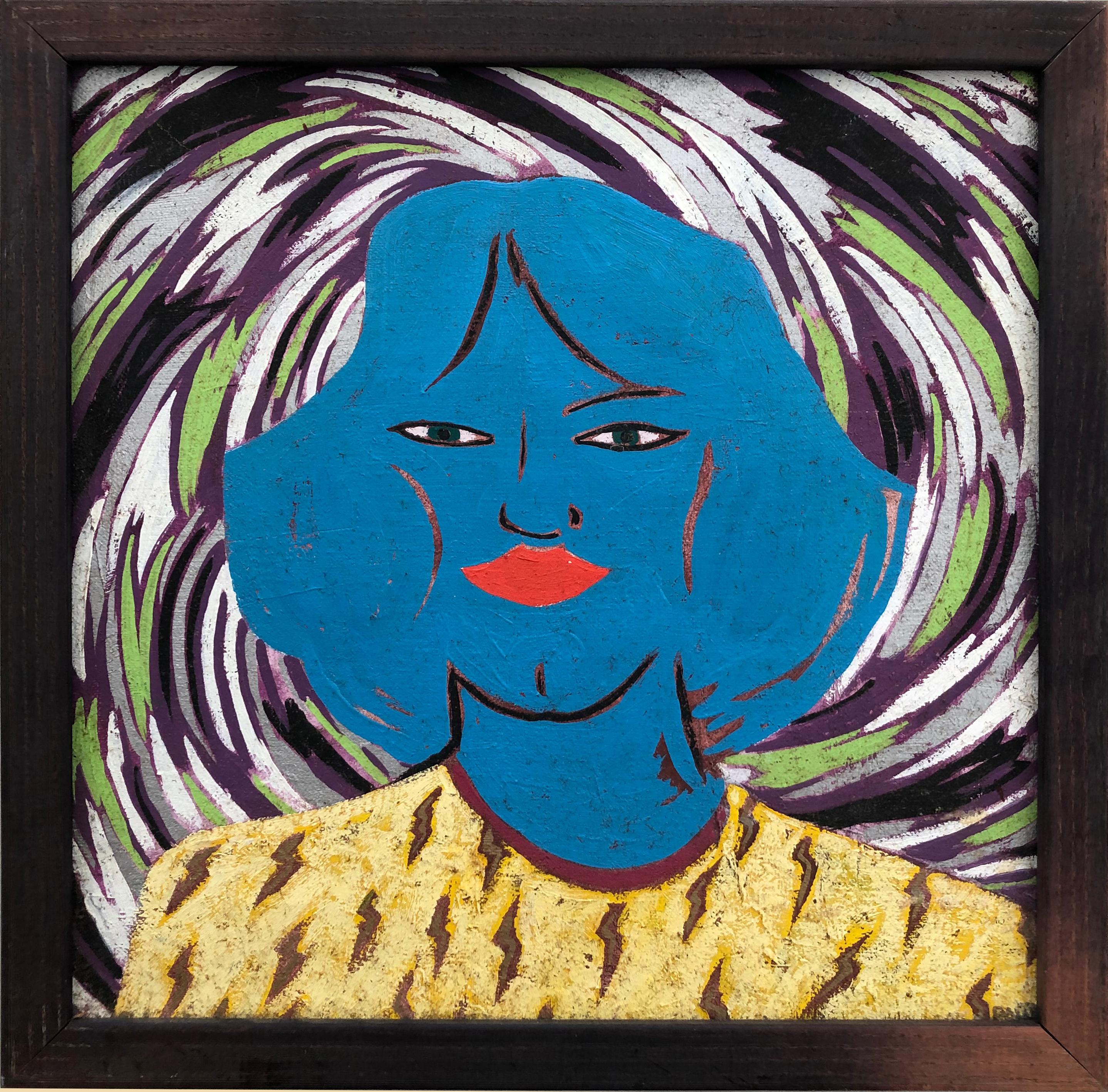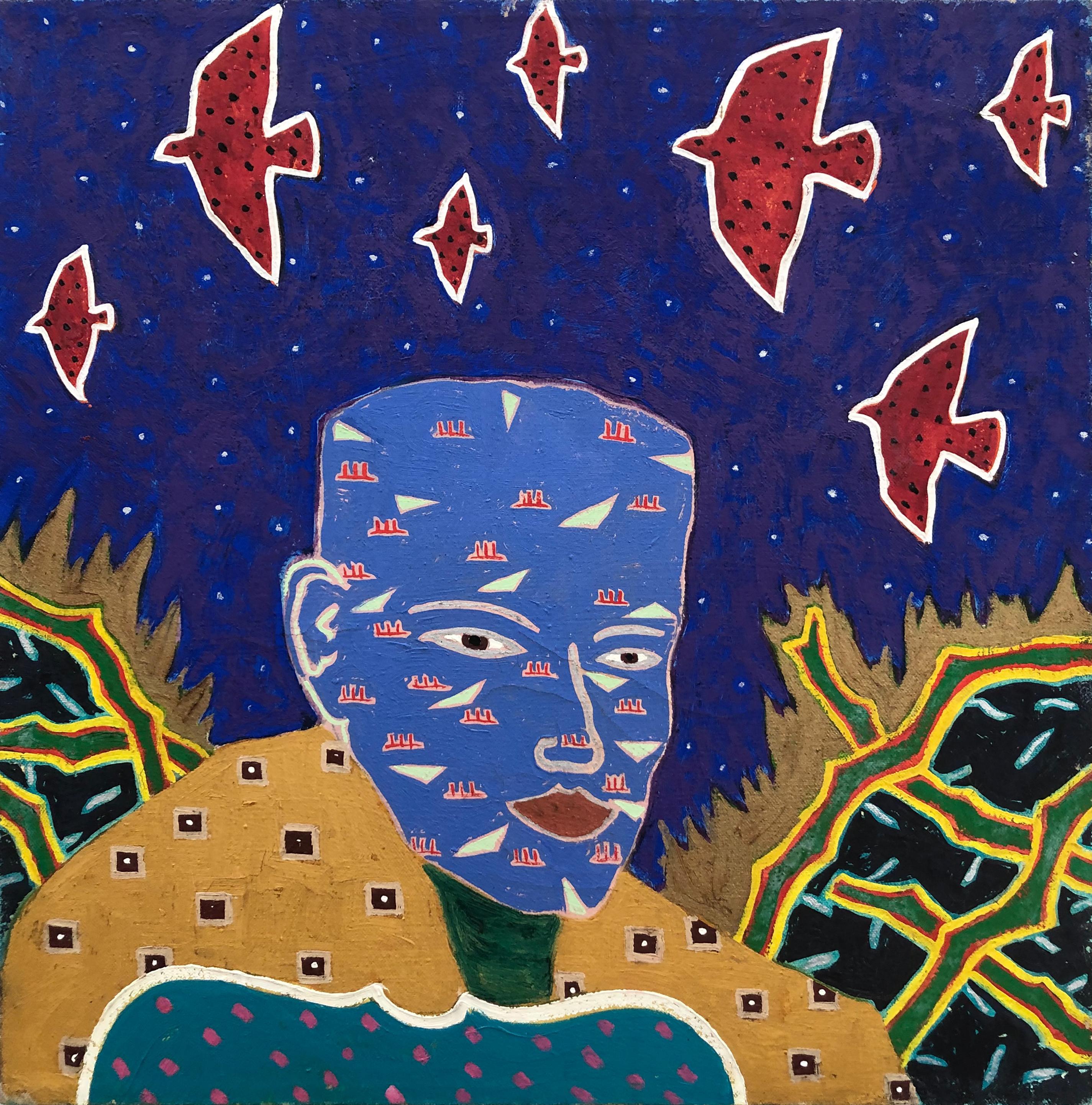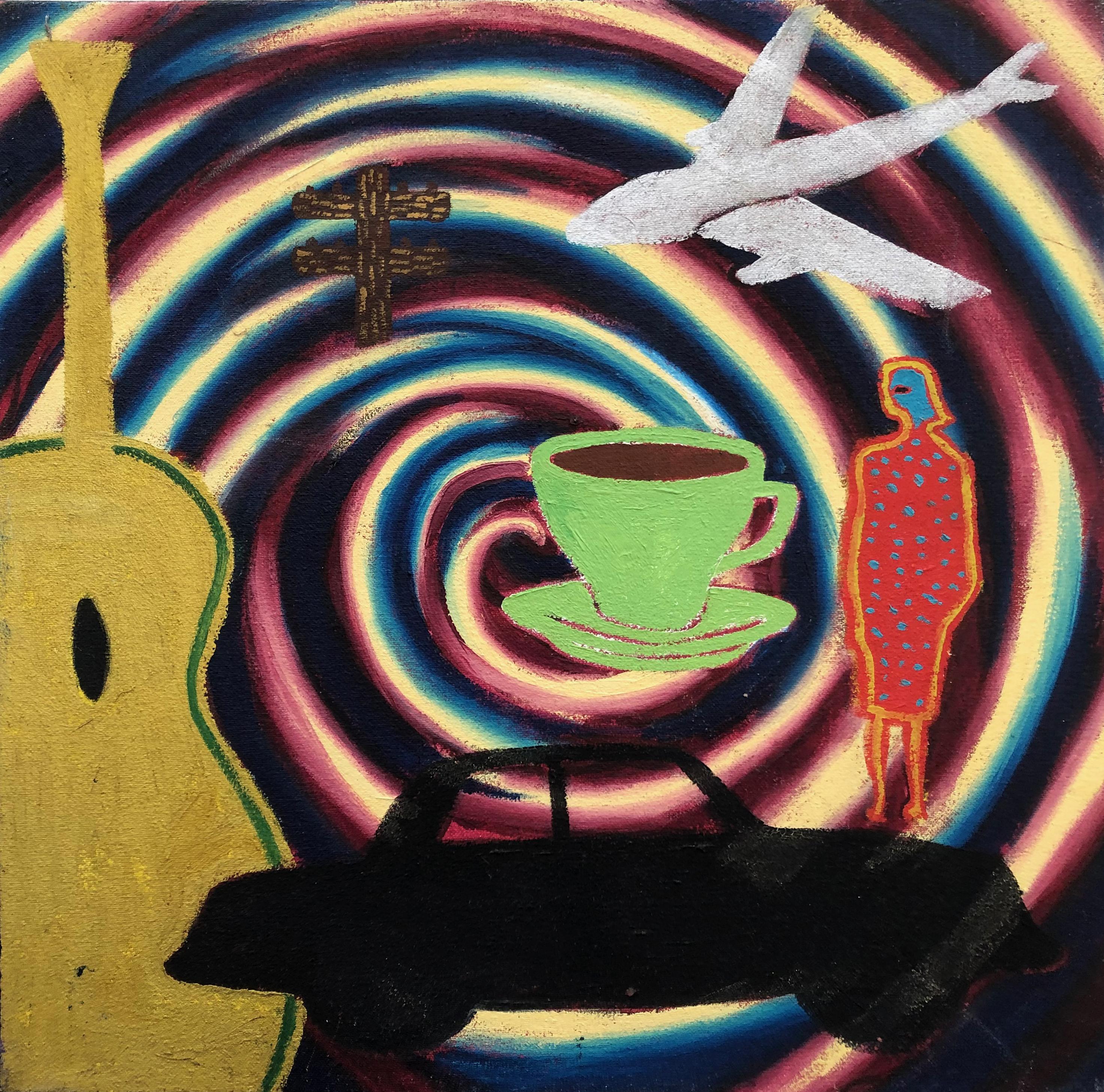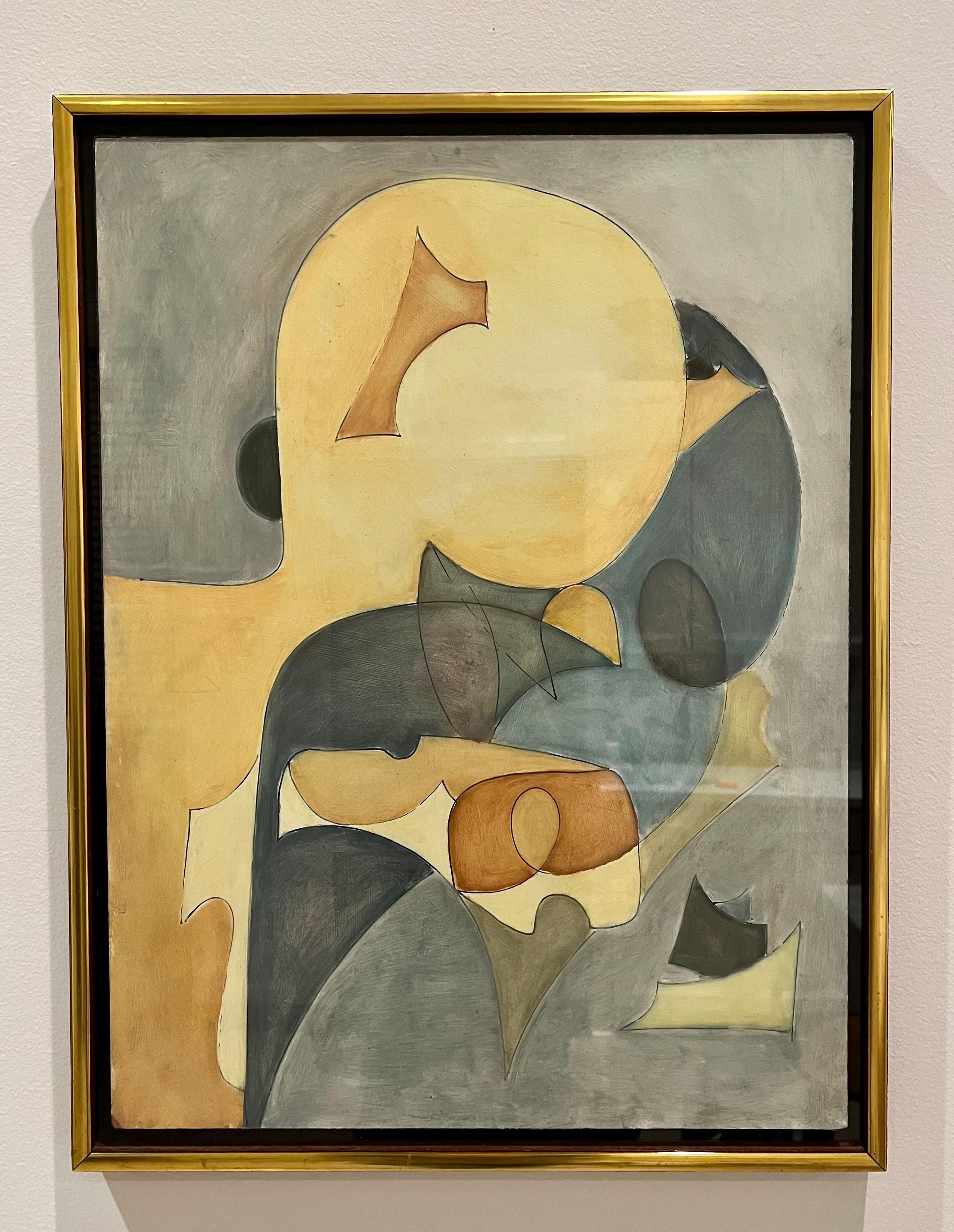Items Similar to Energy Manifestation #4
Want more images or videos?
Request additional images or videos from the seller
1 of 5
Kimon NicolaidesEnergy Manifestation #41933
1933
About the Item
Energy Manifestation #4, 1933, oil on canvas, 24 x 30 inches, signed and dated lower left. Likely exhibited at Nicolaides’ solo show at the Wadsworth Atheneum (Morgan Memorial Building), Hartford, Connecticut, in April, 1933 (see Memorial Opens Varied Display of Nicolaides Work, Originality Distinguishes Creations of New York City Artist, Hartford Courant, April 5, 1933)
About the Painting
This rare work comes from Nicolaides’ energy series, which draws on a unique combination of machine- age aesthetics, Italian-influenced Futurism and French-inspired Surrealism. But, this is a uniquely American work produced in the melting pot of the 1930s metropolis, New York City. Nicolaides uses the ray lines of the American precisionists to frame a pulsating apparatus that unites man and machine as one. The cogs and gears of the fantasy machine seamlessly blend with the hand of its operator. We are left to wonder whether the two are working together in harmony or whether the worker has been absorbed into the machine, like a Depression era robot. In reviewing the 1933 Wadsworth Atheneum show, where works from Nicolaides’ energy series were exhibited, a critic described these paintings as “combining . . . highly imaginative form aspects of machinery and flashes of color which seem to represent light and heat.” The same critic praised the artist, “Mr. Nicolaides here achieves powerful effects with line, mass and color. These pictures are striking for the solidity of the objects portrayed, for their composition and for their delicate orchestration of tones.” Commenting on the same exhibition, Frederick Hynd, the director of the Hartford Art School, noted that “Mr. Nicolaides’ work was noteworthy for its extremely personal sense of color and for its imagination” and that the artist achieved decorative effects “based on emotional ideas.”
About the Artist
Kimon Nicolaides was a painter, muralist, teacher and author. Born in Washington DC, Nicolaides ran away from his home to escape his parents’ opposition to his becoming an artist. He went to New York and enrolled in the Art Students League and supported himself with odd jobs. After serving in the Army during the Great War as a camouflage and map artist, Nicolaides studied and painted in Paris where he exhibited at Bernheim-Jeune in 1922. He then returned to New York where he taught at the Art Students League and the New York School of Applied Design for Women. He exhibited at the Whitney Club (now the Whitney Museum of American Art), the Art institute of Chicago and the Salons of America. In 1932, his work was selected for the early Museum of Modern Art exhibit Murals by American Painters and Photographers. The catalog for this exhibition shows his work next to Georgia O’Keefe’s mural study for Manhattan. Known as a popular and caring teacher, Nicolaides wrote an artists’ how-to manual called The Natural Way to Draw, which was posthumously published in 1941. It has been influential treatise for many decades. His works are in the collections of a number of public institutions, including the Whitney Museum of American Art. Nicolaides is listed in Who was Who in American Art and other standard references.
- Creator:Kimon Nicolaides (1892 - 1938, American)
- Creation Year:1933
- Dimensions:Height: 30 in (76.2 cm)Width: 24 in (60.96 cm)Depth: 2 in (5.08 cm)
- More Editions & Sizes:originalPrice: $15,000
- Medium:
- Movement & Style:
- Period:
- Condition:
- Gallery Location:Los Angeles, CA
- Reference Number:1stDibs: LU1859210017952
About the Seller
No Reviews Yet
Vetted Seller
These experienced sellers undergo a comprehensive evaluation by our team of in-house experts.
1stDibs seller since 2022
6 sales on 1stDibs
Typical response time: 3 hours
- ShippingRetrieving quote...Ships From: Los Angeles, CA
- Return PolicyA return for this item may be initiated within 3 days of delivery.
More From This SellerView All
- The OrchestraLocated in Los Angeles, CAThe Orchestra, 1950, oil on canvas, 21 ½ x 25 3/4 inches, signed and dated lower left, labeled verso “Brown University, Trustee, The Walter Feldman Trus...Category
Mid-20th Century American Modern Abstract Paintings
MaterialsCanvas, Oil
- AbstractLocated in Los Angeles, CAThis painting is part of our exhibition Charles Goeller: A Wistful Loneliness. Oil on canvas, 29 x 22 inches, Signed on frame verso “Painted by Charles L. Goeller” Exhibited: (Perh...Category
1930s American Modern Abstract Paintings
MaterialsOil
- Amish Farmscape #3By Edmund LewandowskiLocated in Los Angeles, CAAmish Farmscape #3, 1984, oil on canvas, 40 x 30 inches, signed and dated lower right; signed, dated, and titled verso About the Painting Amish Farmscape #3 is part of a multi-painting series of barns completed in the early 1980s for an exhibition at New York’s prestigious Sid Deutsch Gallery. Lewandowski painted this work at an important point in his career. It was the first major project undertaken by Lewandowski after his retirement from serving as the Chairman of Winthrop University’s Art Department, the last academic position he held after teaching for nearly thirty years. Lewandowski had been inspired to work on the series by a visit to Lancaster County, Pennsylvania. Like his friend and mentor, Charles Sheeler, Lewandowski had always been fascinated by vernacular architecture and the Amish barns of Pennsylvania brought back memories of rural scenes Lewandowski had painted in the Midwest much earlier in his career. Amish Farmscape #3 is a strong example of Lewandowski’s late precisionist work. The complexity of the composition and Lewandowski’s technical acumen are on full display. Being relieved of the burdens of teaching and administering a university art department likely allowed Lewandowski greater freedom and most importantly more time to complete the Amish Farmscape series. Although Lewandowski’s brand of precisionism changed throughout the years, he never deviated from the core tenets of the Immaculate School artists. In this work, we see simplified and flattened forms, the use of ray-lines to define light and space, the elimination of extraneous details, a polished almost machine-like finish, and the complete lack of visible brushstrokes, all hallmarks of the precisionist painters. Lewandowski was the last of the 20th century precisionists and in Amish Farmscape #3, we see just how successfully he continued to work in this style until his death in 1998. About the Artist Edmund Lewandowski was among the best of the second-generation precisionist painters. He was born and raised in Milwaukee, Wisconsin and studied at the Layton School of Art with Garrett Sinclair. Lewandowski achieved early success when in 1936 two of his watercolors were shown at the Phillips Collection as part of a Federal Art Project exhibition. Then, in 1937, his work was first exhibited at Edith Halpert’s Downtown Gallery which represented Lewandowski into the 1950s. Under Halpert’s guidance, Lewandowski continued to explore watercolor as his main medium during the 1930s and 1940s, since the gallery already represented Charles Sheeler, who worked primarily in oils. Sheeler became Lewandowski’s major influence as the primary leader of the ill-defined, but very recognizable Immaculate School artists, which included other Downtown Gallery painters, Niles Spencer, George Ault, and Ralston Crawford, as well as Charles Demuth and Preston Dickinson, both of whom died at a young age and had been represented by the Charles Daniel Gallery. Sheeler is credited with giving Lewandowski technical advice on how to make his paintings more precise and tightly rendered and by all accounts, Sheeler was a fan of Lewandowski’s work. Through the Downtown Gallery, Lewandowski’s paintings were accepted into major national and international exhibitions and purchased by significant museums and collectors. Franklin and Eleanor Roosevelt and Nelson Rockefeller acquired works by Lewandowski. He was included in the Museum of Modern Art’s important 1943 exhibition, American Realists and Magic Realists as well as juried exhibitions at the Whitney Museum of American Art, the Pennsylvania Academy of Fine Arts, and the Art Institute of Chicago. Lewandowski also completed commissions for magazines during the 1940s and 1950s, including several covers for Fortune. Throughout his career, Lewandowski explored urban and rural architecture, industry, machinery, and nautical themes. Looking back on his career, Lewandowski wrote, “My overwhelming desire as an artist through the years has been to record the beauty of man-made objects and energy of American industry on canvas. For as far back as I can recall, the cityscapes, farms and depictions of industrial power and technological efficiency has had a great attraction for me. I try to treat these observations with personal honesty and distill these impressions to a visual order.” Lewandowski is credited with extending precisionism to the Midwest and successfully continuing the style into the 1990s, three decades after Sheeler’s death and six decades after Demuth’s passing. Late in his career, Lewandowski enjoyed a resurgence of popularity as he was represented during the 1980s by New York’s Sid Deutsch and Allison Galleries...Category
Mid-20th Century American Modern Landscape Paintings
MaterialsCanvas, Oil
- Abstract Street (Untitled)By Hananiah HarariLocated in Los Angeles, CAThis painting is part of our exhibition America Coast to Coast: Artists of the 1930s Abstract Street (Untitled), 1939, oil on canvas, signed and dated lower right, 12 x 32 inches; provenance includes a private collection in Venice, California; presented in what is likely the artist's original handmade frame About the Painting The present work is the culmination of a series of mainly horizontal urban abstractions Harari completed between 1937 and 1939. Deeply influenced by Stuart Davis, Harari’s New York streetscapes began with clearly recognizable objects and landmarks as in Into New York (1937 - Collection of the Whitney Museum of American Art), New York Harbor (1937), Up and Downtown (1938), and his other mural proposals for the Nurses Home on Welfare Island (1937) and the Williamsburg Housing Project (1938). At the end of the series, Harari’s vistas became increasingly abstract with broad planes of color representing buildings and streets, the slightest cross-hatching forming a bridge or elevated train track and the vague suggestion of a streetlight looping in the right center of the composition. Figures, birds, and a street vendor’s cart are reduced to pictograms scratched into the surface of the canvas. Abstract Street (Untitled) is among Harari’s most spare works of the 1930s and 1940s and calls to mind the seemingly childlike, but deeply sophisticated works of Paul Klee from the 1920s. It serves as an excellent reminder of why Harari was heralded as one of the earliest members of the American Abstract Artists. About the Artist Hananiah Harari was an artistic polyglot who was equally at home working in styles as diverse as Cubism, Constructivism, Expressionism, Hard Edged Abstraction and trompe l’oeil Realism. A native of Rochester, New York, Harari initially studied as a child at the Memorial Art Gallery in his hometown and later as a scholarship student at the College of Fine Arts at Syracuse University. In 1932, Harari left for Paris where he befriended Nahum Tschacbasov, Benjamin Benno and John Graham and studied at the ateliers of Lhote, Leger and Gromaire. He also studied fresco painting at the Ecole de Fresque. By 1933, Harari had completed enough work and gained a sufficient reputation to have a solo exhibition at the American Club in Paris. The following year, Harari and his childhood friend and fellow artist Herzl Emanuel traveled to Palestine, where the artists worked hard in the orchards and fields of Kibbutz Deganiah, but produced little art. After returning to New York, Harari married Emanuel’s sister, Freda, and set out on the development of what noted scholar Gail Stavitsky has called an “original synthesis of the old and new." Harari became an early member of the American Abstract Artists (AAA), an organization formed to give modernists exhibition opportunities. Harari was also a member of the socially conscious Artist’s Union and the American Artist’s Congress. From 1936 through 1942, Harari worked on the Federal Art Project and assisted Marion Greenwood on a project as part of the Mural Division, but to his disappointment did not lead his own project. During the late 1930s and early 1940s, Harari completed a series of paired paintings with the same subject matter depicted in a Cubist manner and in trompe l’oeil Realism. Harari was acclaimed by Clement Greenberg and six of the artist’s works were selected for the Museum of Modern Art’s important 1943 exhibition American Realists and Magic Realists. During World War II, Harari served in the US Army Air Corps. Following the war, Harari continued to produce fine art while also producing commercial art. During the McCarthy Era, Harari’s progressive politics and leftist leaning art...Category
1930s American Modern Abstract Paintings
MaterialsOil
- Homage to LegerBy Jean KelloggLocated in Los Angeles, CAThis painting is part of our exhibition America Coast to Coast: Artists of the 1940s. Homage to Leger, 1941, oil on canvas, signed and dated lower right, 14 x 17 inches; inscribed ...Category
1940s American Modern Paintings
MaterialsCanvas, Oil
- Untitled (Cubist Portrait)By Jerre H. MurryLocated in Los Angeles, CAThis work is part of our exhibition - America Coast to Coast: Artists of the 1940s Untitled (Cubist Portrait), 1945, oil on masonite, signed and dated lower middle, 20 x 16 inches,...Category
1940s American Modern Paintings
MaterialsOil, Masonite
You May Also Like
- Swirling WomanBy FPA Francis Pavy ArtistLocated in Lafayette, LAThis small work depicts a Blue woman's figure with Red lipstick attired in yellow situated against a swirling purple, Green, black, and silver back ground. this work is framed. S...Category
1980s American Modern Abstract Paintings
MaterialsOil
- ACCORDIONIST WITH NIGHT FLOCKBy FPA Francis Pavy ArtistLocated in Lafayette, LAThis work depicts a central figure with a blue face. A Turquoise violin-type shape is in the foreground. The figure is flanked by two areas of multi-colored briars that are Burning. ...Category
1990s American Modern Abstract Paintings
MaterialsOil
- Sunset portraitsBy FPA Francis Pavy ArtistLocated in Lafayette, LAThis small painting is entitled Sunset Portraits. It's an oil painting on canvas mounted on wood. The painting depicts a man's silhouette formed by fl...Category
2010s American Modern Abstract Paintings
MaterialsOil
- Deep South TravelBy FPA Francis Pavy ArtistLocated in Lafayette, LAThis abstract work features several Pavy Design icons a waist a swirling red, yellow, and Deep blue Background. These Icons include a Coffee cup, Acoustic guitar, a telephone pole...Category
1990s American Modern Abstract Paintings
MaterialsOil
- Moon Glow by Robert TerryLocated in Brookville, NYBorn 1955 in Broken Bow, Nebraska. Lives and works in New York. AWARDS National Endowment for the Arts, Major Grant Robert Terry was best noted in his depictions of romantic moons...Category
1990s American Modern Landscape Paintings
MaterialsOil
- American School, Abstract UntitledLocated in New Orleans, LAAmerican School, Artist UnknownCategory
Early 20th Century American Modern Abstract Paintings
MaterialsOil, Board
Recently Viewed
View AllMore Ways To Browse
Energy Art
4 X 5 Frames
Mural Study
4 Italian Paintings
Machine Age American Design
Metropolis Modern
Abstract Futurism
Depression Era
America Vintage Map
America Map Vintage
Vintage American Map
Vintage American Maps
Depression Era Art
4 Inch Pot
Vintage Map Of New York
Vintage Machine Oiler
Italian Oil Pot
Man O War





